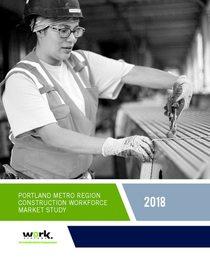DIVERSITY ON WORK SITES IS AN ONGOING COMMITMENT
The following article by Worksystems staff Kelly Haines was featured in the Portland Business Journal on May 24, 2019.
As the ongoing economic recovery has led to business growth and infrastructure investments, the construction sector has boomed, making it a high-growth industry in the Portland Metro Area. However, the career opportunities generated by this growth are not equitably accessible to everyone in the community. Construction has historically been a male-dominated and racially homogenous industry, and this continues to be the case. At the same time, construction businesses report a severe shortage in skilled talent — a claim that is supported by labor market data.
To help better understand the major barriers to increasing diversity in the trades, Worksystems, the local Workforce Investment Board that serves Multnomah and Washington counties, performed an in-depth yearlong Regional Construction Workforce Market Study, commissioned by Metro and the City of Portland.
The research study included collecting and analyzing existing available construction workforce supply data, forecasting the local five-year workforce demand, conducting extensive interviews with public agencies, contractors, apprenticeship programs, and pre-apprenticeship programs and holding focus groups with diverse construction workers and foremen in the region.
The research sought to uncover the major barriers to achieving equity and increasing diversity in the construction workforce for the Portland metro area. A set of recommendations for success are outlined and described in the report. The study’s findings fall into three overarching recommendation areas: Increase recruitment of women and people of color, primarily through improving word of mouth success and better marketing of these careers; Increase retention of existing diverse workers by creating more robust and ongoing support and better addressing the worksite culture; and develop more robust equity policies and practices that lead to better outcomes on public capital projects and for the industry as a whole.
It will take significant commitment to truly increase the numbers of women and people of color in the trades. But, without them, the industry will be challenged to meet its workforce needs. Retirements and a lack of trades in the public school system have all contributed to a projected severe shortage of skilled labor in the pipeline.
As data have shown, however, targeted and intentional policy efforts are needed to bring tangible results. For example, the city of Portland applied Community Benefit Agreements on two major capital projects in the region which resulted in historic outcomes.
A CBA is an agreement between public or private institutions and the contractors, union and community representatives working on large public works projects and outlines clear and enforceable goals and targets with built-in oversight to ensure both workforce and contracting diversity. The City of Portland CBA pilot projects achieved nearly double and triple the stated goals, in most cases.
Similarly, Multnomah County currently has robust diversity goals on its Health Department headquarters and Courthouse projects in their Project Labor Agreements, which has led to substantially increased career opportunities for women and people of color on these jobsites.
All too often, however, these types of policies have been enacted without true commitment or real outcomes tracking, and no one has benefited from “good faith efforts” without real action. Currently, Metro is leading on a regional effort to bring public owners together to standardize their approach on these policies, and now is the time for them to come together to decide on meaningful policies for their public contracting. A regional framework is expected by July 2019, and it is an incredible opportunity for our local public jobsites to create stable employment opportunities where women and people of color can journey out and become a significant part of our shared labor pool to draw from over the years.
Additionally, many industry leaders have also recognized the urgency of addressing the culture in construction. They have recognized that it is imperative to improve jobsite culture: it will attract and keep good and diverse talent and also improve safety and productivity. Hoffman is piloting a bystander intervention program called “Green Dot” on the Multnomah County Courthouse and is working to also roll it out on future projects in the region over the next year. This model is based on the premise that a “green” dot is one’s individual commitment as a bystander to counteracting “red” dots, those moments when words, choices, or actions lead to power-based personal violence. The NW Carpenters Institute has developed their own Positive Jobsite Culture Training, which they have used to train over 3,000 tradespeople to date, including Supervisors and Foreman. We have also developed a Positive Jobsite Culture Pledge as a rallying point for leaders in the region to commit to, and have had over 20 large contractors, labor unions, and trade associations sign on to work together at the regional level.
In order to truly create an industry where more diversity is realized, contractors and public owners need to boldly lead on owning policies that embody accountability and a proactive approach to bringing more diverse workers into the field and keeping them in lifelong career opportunities.
Kelly Haines is the Business Services Manager at Worksystems, where she works with industry leaders to develop and implement a regional workforce plan to support the construction trades and she staffs the Metropolitan Alliance for Workforce Equity, a coalition of labor, community, training and contractor partners working to advance equity in the construction trades.

